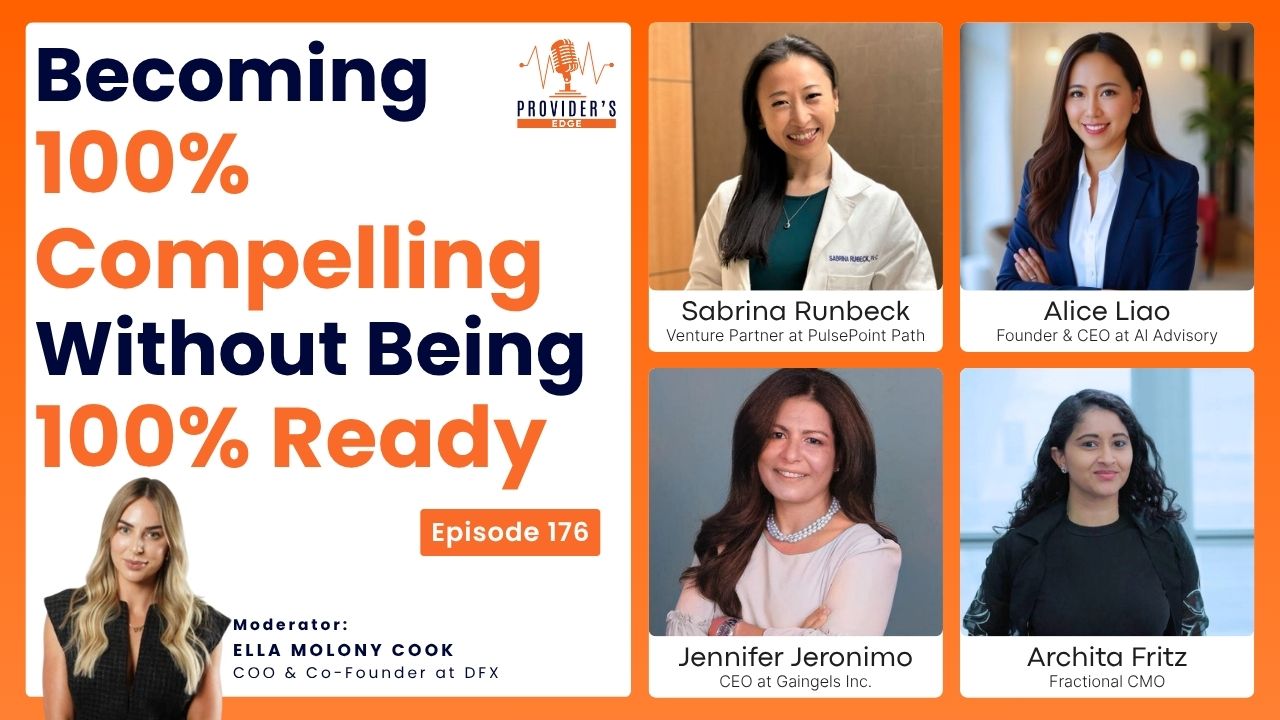
What Do Investors Really Want to Hear
in a FemTech or Diagnostic Pitch?
Uncover how to turn your data and mission into investor trust—without sounding too technical or too emotional.
Listen anywhere you get your podcastin' on.
Live Interview

How Do You Avoid Over-Explaining in Investor Pitches?
Most FemTech founders try to say too much too soon. The result? Investors disengage.
This happens most often when founders lead with the how—the science, the workflow, the tech stack—before building emotional or economic stakes. If your first few slides walk through methodology, the investor is mentally checked out by the time you get to your Ask.
Instead, lead with transformation over technology. In the first 30 seconds, focus on:
- The emotional or economic pain point
- Who specifically suffers that pain (the niche, underserved group)
- What new future your product enables
Example:
“Millions of women wait 7+ years for an endometriosis diagnosis. We cut that to 6 months—and reduce costs by 40%.”
Your data matters. But only after you’ve built urgency and relevance.
🔍 Pro Tip: Use headlines on your slides that state outcomes, not categories. Instead of “Technology Overview,” try “How We Cut Diagnosis Time by 85%.”
What Data Actually Counts as Traction Before You Have Revenue?
Let’s be real: many diagnostic and digital health companies won’t have revenue in early stages. But that doesn’t mean you have “no traction.”
Investors are trained to recognize early signals of market readiness and founder execution. Here’s what counts:
- ✅ Clinical pilot or POC results, even with small n sizes, if visualized clearly
- ✅ Outcome-based validation (e.g. “Reduced readmission risk by 32%”)
- ✅ Letters of Intent from buyers or partners
- ✅ IRB approvals or regulatory progress steps (e.g. pre-sub with FDA)
- ✅ Backers or believers, even 1-2 early checks from respected angels or VCs
📊 Example: One founder had a 20-person pilot with a 93% sensitivity rate. But her pitch landed once she translated that into: “For every 100 women screened, we detect 30% more early cases—and save $1,200 per patient.”
🚫 Don’t flood your deck with dense tables. Use visual storytelling to show before-and-after states, timelines, or cost comparisons.
Should the Customer or the Founder Be the Hero of Your Story?
Investors need to believe in you, but they fund transformation. So when building your pitch story, make your customer the hero.
This is the classic “Hero’s Journey” format reframed for pitching:
- The Villain: Long delays, poor outcomes, silent suffering (e.g., late-stage diagnosis)
- The Hero: Your customer—an underserved patient, provider, or payer
- The Guide: You—offering the tool, insight, or solution
- The Elixir: Your product—helping them win, save, grow
- The Ask: Invite the investor to fund more heroes like this
📖 Example: A mental health startup reframed their pitch from a platform tour to a transformation story: “We helped a young teen go from misdiagnosis and school expulsion to same-day treatment and full classroom reintegration. Now, we’re scaling that journey to 10,000 more families.”
Investors leaned in—not because they understood the tech, but because they saw the impact.
How Do You Translate Mission Without Sounding Like a Nonprofit?
If you’re serving an underserved population, leading with equity or advocacy can sometimes trigger investor bias—especially in generalist VCs who don’t see the immediate path to returns.
But that doesn’t mean abandoning your mission. It means pairing impact language with market math.
Here’s how:
- “We help Black maternal patients avoid postpartum ER visits”
→ “A $10.9B opportunity to reduce unnecessary readmissions” - “We support teens with anxiety”
→ “A market of 18M families who spend $3,200+ annually on fragmented care” - “We prioritize Medicaid populations”
→ “Our beachhead: a payer segment with $17B in preventable spend”
🧠 Tip: Use your founding story in your intro—especially if it’s lived experience. Then quickly pivot to the business model and market.
🎙️ Quote from a Series A FemTech founder:
“I had to learn that being mission-driven didn’t mean I had to over-explain. It meant I had to translate.”
What Can You Do Now to Make Investors Lean In Faster?
Here’s your next 24-hour playbook to upgrade your pitch:
- Rewrite your hook slide. Start with a sharp outcome + TAM + urgency.
- Bullet your proof. Pick 3 traction signals (data, LOI, advisory support).
- Add a customer voice. Even a quote from a beta user helps personalize.
- List 3 milestones. What’s your 6-month traction roadmap? Show execution.
- Use the Hero’s Journey. Put the user at the center of the pitch.
🧪 Bonus: Record your pitch and play it back. Are you explaining or inspiring?
Where Can You Get Feedback From Investors Who Understand FemTech and Diagnostics?
Most investors don’t get your space. That’s why you need a curated room.
Join our next PulsePoint Pitch Tank where:
- Founders present to aligned investors
- Feedback is specific, strategic, and actionable
- You connect with others translating complex ideas into funding
👉 Apply to Pitch or Attend → PitchToYes.com
Here are 3 ways we can support you right now:
🎤Be a Featured Guest on the Provider’s Edge
Have traction and a story to share? Apply to join us on the show: PulsePointPath.com/Call-Sabrina
🎯 Get You In Front of Investors
We match you with the most aligned investors and decision-makers who care about your niche already. Apply at PulsePointPath.com/Pitch-Application
About Sabrina Runbeck
Sabrina Runbeck, MPH, MHS, PA-C helps healthcare technology companies scale sustainably—without burning out their teams or running out of cash. She is the Co-Founder of PulsePoint Path and works alongside a 12-integrated board of advisors to help founders make strategic decisions that multiply impact and protect capital. Her signature 5D Integrated System helps companies move beyond one-dimensional problem solving—what they think the issue is—and instead, builds an Empowered Ecosystem across leadership, team dynamics, and systems alignment. This is how founders evolve from early traction to 10x growth. Sabrina is also a TEDx speaker, former Cardiothoracic Surgery PA, and trusted advisor with over 15 years of experience in public health, neuroscience, and business acceleration.
★ NEXT STEP ★
Need clarity on your hiring or onboarding strategy?
Let’s create your people-powered growth blueprint in under 5 hours 👉 PulsePointPath.com/Call
Recommended Podcast Episodes
Be a guest on our show
The Provider's Edge show is always looking to feature healthcare change-makers and celebrate the work they are doing to improve healthcare.
Together, we can encourage other healthcare entrepreneurs and startup founders to up-level their businesses.
If you or someone you know could be a good fit as a guest on the show, please click on the bottom below to apply as a speaker.
Healthcare Entrepreneurs!
I can help you gain visibility and credibility in the right circles so you can accelerate your mission and profitability!
After overcoming burnout working in surgery, I went back to my roots in neuroscience and public health. I learned the importance of building key human relationships with my team throughout our organization.
While helping healthcare executives and entrepreneurs to get out of the day-to-day operation of their practice, I realized I needed more visibility and more connections to reach my ideal clients.
Once I set out to be highly visible in the right circles, I was able to leverage my network of strategic partners to convert clients 5x higher than any other marketing channel I had tried previously.
Now I help healthcare change-makers to accelerate their impact and increase profitability by gaining visibility and credibility with the right strategic partners.
My clients no longer worry about where their next client is coming from, the need to plan additional budget for ads spending, or losing the ability to connect with others because their social media account is shut down.
If you want to share your social mission with the world and gain pivotal supporters that become loyal clients... then you are in the right place, with the right consultant who is also a recovered clinician.




